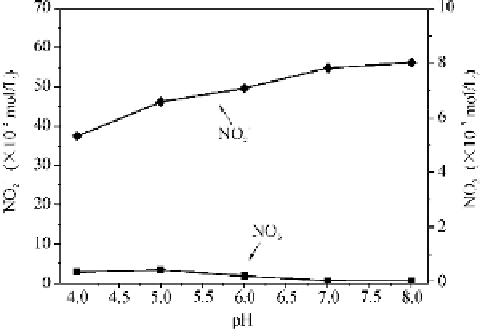Environmental Engineering Reference
In-Depth Information
Fig. 4.9
Concentration of ions at different pH values with the existence of S(IV)
4.4.3 Effect of the Initial NO
2
Concentration
Experiments were carried out with typical solution parameters (i.e., a pH value of
5.5 with 0.01 mol/L tetravalent-S existence) that are usually used in desulfurizers.
Fig. 4.10 shows the removal efficiency variation with the initial concentration of
NO
2
. The removal efficiency decreases a little from 74 to 68% as the initial NO
2
concentration increases from 100 to 400 ppm. The variation behavior of the
concentration ratio of NO
2
/NO
3
can also be analyzed from this figure. The
NO
2
/NO
3
concentration ratio actually represents the comparison between the
redox reactions and NO
2
hydrolysis. It is concluded that advancing the two
reactions in Eqs. (4.10) and (4.11) can increase the ratio, while strengthening the
NO
2
hydrolysis, on the contrary, decreases the ratio value. The figure shows that
the NO
2
/NO
3
ratio decreases from 220 to 78 as the initial NO
2
concentration
increases from 100 to 400 ppm; this means that the proportion of the redox
reactions decreases. The reaction rates in Eqs. (4.10) and (4.11) can be expressed
as
k=k
o
×[S(IV)]×[NO
2
]. With increasing the NO
2
concentration and maintaining
the total tetravalent-S (denoted by S(IV) here) concentration, both the first order
reaction rate constant
remain constant, while the
absorbed NO
2
increases, thus increasing the S(IV) depletion in the solution.
Accordingly, the concentration of H
+
generated from reactions in Eqs. (4.10) and
(4.11) increases. These circumstances favor the occurrence of the reverse reactions
listed in Eqs. (4.8) and (4.9), thereby decreasing the NO
2
consumption in the
redox reactions. Consequently, the ratio of NO
2
/NO
3
decreases clearly with the
k
o
×
[S(IV)] of NO
2
and

Search WWH ::

Custom Search